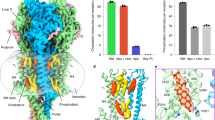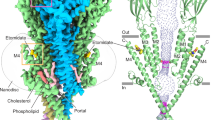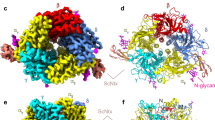Abstract
MUSCARINIC receptors have been characterised extensively in intact smooth muscle1–3 and in subcellular fractions from smooth muscle2,4–6 and brain7–10 by reversible binding of labelled atropine1,9,10, propylbenzilylcholine9,10, quinuclidinylbenzilate (QNB) (refs 6, 8) and benzetimide4,5, or by alkylation with benzilylcholine2 or propylbenzilylcholine mustard3,7,9–11. Several attempts to solubilise muscarinic receptors2,4,12 have failed due to the inhibition of receptor binding by the detergent used for solubilisation2,4. We report here the solubilisation with 2M sodium chloride of an atropine-binding material from the ox cerebral cortex, which has properties similar to those found for the muscarinic receptor in subcellular preparations.
This is a preview of subscription content, access via your institution
Access options
Subscribe to this journal
Receive 51 print issues and online access
$199.00 per year
only $3.90 per issue
Buy this article
- Purchase on Springer Link
- Instant access to full article PDF
Prices may be subject to local taxes which are calculated during checkout
Similar content being viewed by others
References
Paton, W. D. M. & Rang, H. P. Proc. R. Soc. B 163, 1–44 (1965).
Fewtrell, C. M. S. & Rang, H. P. in Drug Receptor (ed. Rang, H. P.) 211–224 (Macmillan, London, 1973).
Burgen, A. S. V., Hiley, C. R. & Young, J. M. Br. J. Pharmac. 50, 145–151 (1974).
Beld, A. J. & Ariens, E. J. Eur. J. Pharmac. 25, 203–209 (1974).
Beld, A. J., Van Den Hoven, S., Wouterse, A. C. & Zegers, M. A. P. Eur. J. Pharmac. 30, 360–363 (1975).
Yamamura, H. I. & Snyder, S. H. Molec. Pharmac. 10, 861–867 (1974).
Burgen, A. S. V., Hiley, C. R. & Young, J. M. Br. J. Pharmac. 51, 279–285 (1974).
Yamamura, H. I. & Snyder, S. H. Proc. natn. Acad. Sci. U.S.A. 71, 1725–1729 (1974).
Hulme, E. C., Burgen, A. S. V. & Birdsall, N. J. M. Colloquium on the Physiology and Pharmacology of Smooth Muscle, Proc. INSERM 50, 49–70 (1976).
Birdsall, N. J. M., Burgen, A. S. V., Hiley, C. R. & Hulme, E. C. J. Supramolec. Struct. 4, 367–376 (1976).
Birdsall, N. J. M. & Hulme, E. C. J. Neurochem. 27, 7–16 (1976).
Bartfai, T., Anner, J., Schultzberg, M. & Montelius, J. Biochem. biophys. Res. Commun. 59, 725–733 (1974).
Burgen, A. S. V. & Spero, L. Br. J. Pharmac. 34, 99–115 (1968).
Gray, F. G. & Whittaker, V. P. J. Anat. 96, 79–88 (1962).
Meunier, J. C. & Changeux, J. P. FEBS Lett. 32, 143–148 (1973).
Author information
Authors and Affiliations
Rights and permissions
About this article
Cite this article
CARSON, S., GODWIN, S., MASSOULIE, J. et al. Solubilisation of atropine-binding material from brain. Nature 266, 176–178 (1977). https://doi.org/10.1038/266176a0
Received:
Accepted:
Issue Date:
DOI: https://doi.org/10.1038/266176a0
This article is cited by
-
Muscarinic receptors binding in retinal pigment epithelium during rat development
Neurochemical Research (1994)
-
Neurochemical studies on imprinting behavior in chick and duckling
Neurochemical Research (1985)
Comments
By submitting a comment you agree to abide by our Terms and Community Guidelines. If you find something abusive or that does not comply with our terms or guidelines please flag it as inappropriate.



